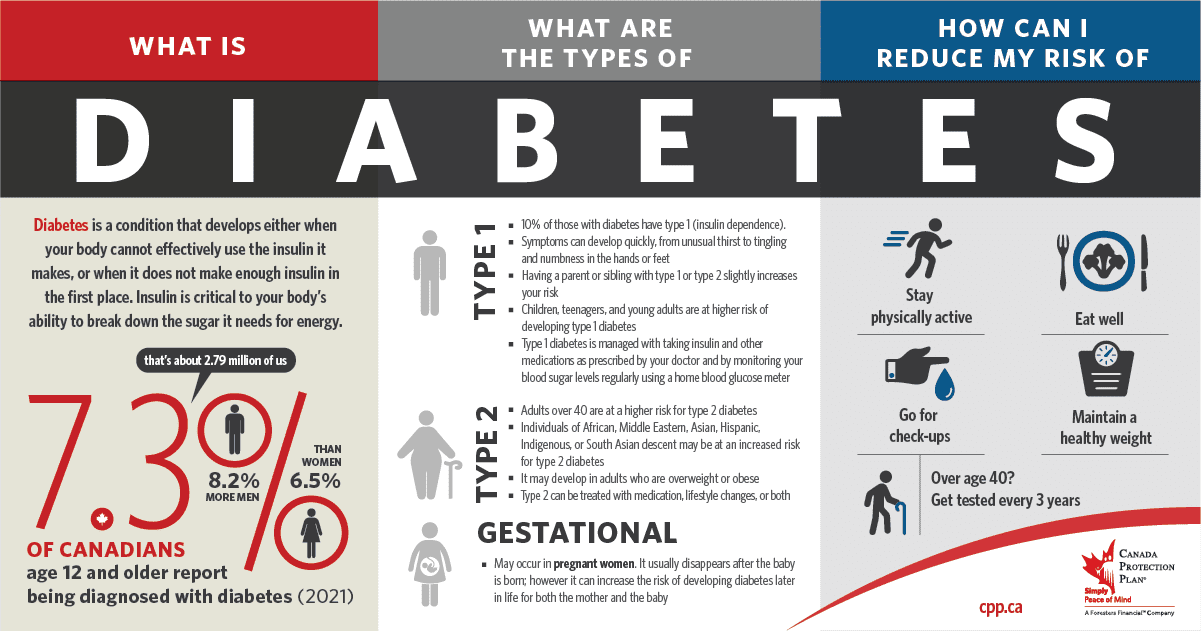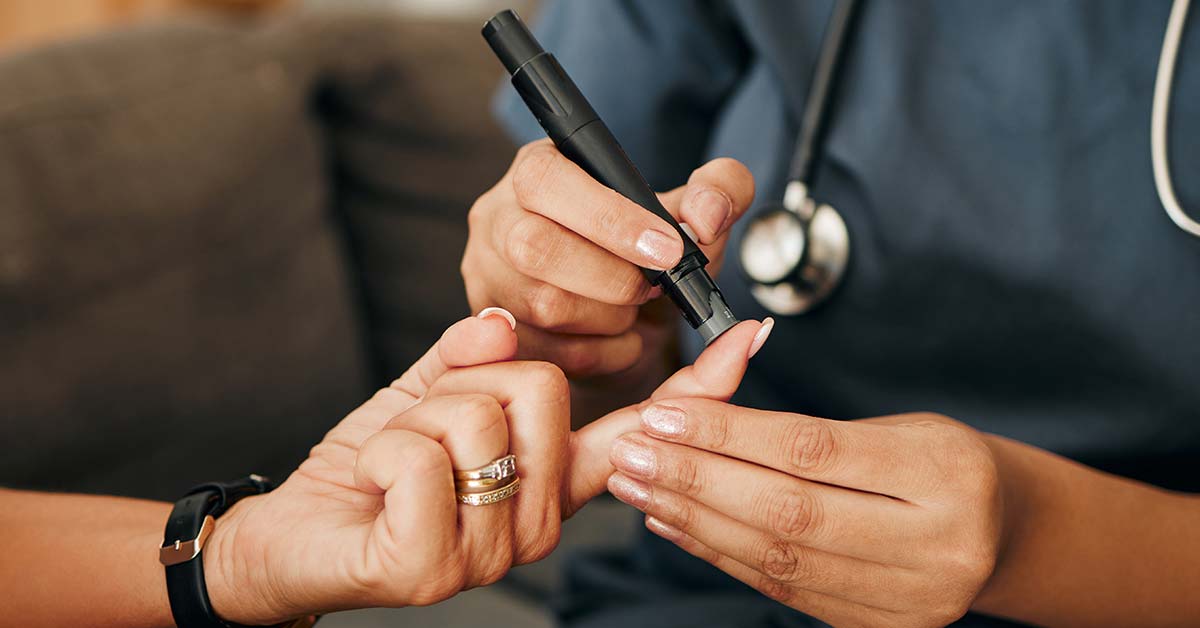Whether you have diabetes or other health conditions, you can be covered by one of our life insurance plans!
Applying is easy
No medical* life insurance for up to $500,000 in coverage
18 or 80, you can apply! This includes temporary residents with a valid work or study permit
Get a free no-obligation quote
How Much Control Do We Have Over Diabetes?
Conventional wisdom about treating and controlling diabetes, especially type 2 diabetes, constantly changing. Researchers are finding significant evidence to support the use of glucose-lowering drugs to help control blood sugar as one of the most important ways to fight type 2 diabetes. In Canada, 71.7 percent of people with diabetes used medication to manage their condition.1
While the research continues in searching for the most effective treatments for diabetes, Canadians living with this disease should take necessary precautions, both medical and financial.
Securing life insurance protection for your loved ones while living with diabetes isn’t just possible, it’s also simple and affordable – and it doesn’t involve needles or blood tests.
Fill out the form on this page and get a free quote today!
Additional information on Diabetes
Diabetes in Canada
Here are some of the most recent nationwide statistics on diabetes in Canada:2
- According to the complete data currently available (2020-2021), almost 3.7 million Canadians (9.4 percent) are living with diabetes.
- From 2007 to 2019, about 22.5 percent of Canadians 20-79 who met the diagnosis criteria for diabetes were unaware of their condition.
- More men (10.1 percent) than women (8.7 percent) have diabetes.
What is diabetes?
Diabetes is a condition that develops either when your body cannot effectively use the insulin it makes or when it does not produce enough insulin in the first place. Insulin is critical to your body’s ability to break down the sugar it needs for energy. Without insulin, sugar builds up in the blood.
What are the types of diabetes?
There are three kinds of diabetes:
- Type 1 diabetes happens when the pancreas no longer makes insulin. It usually develops in children, teenagers and young adults. About 5-10 percent of Canadians2 living with diabetes have diabetes have type 1, which is treated with insulin.
- Type 2 diabetes happens because the pancreas does not make enough insulin. Or if it does, the body cannot effectively use that insulin. About 90-95 percent of Canadians1 living with diabetes have type 2, which may be treated with medication, lifestyle changes or both.
- Gestational diabetes occurs in 10 percent of women who give birth.2 It usually disappears after the baby is born, but it can increase the risk of developing type 2 diabetes later in life for both the mother and the baby.
What is prediabetes?
As your blood glucose rises and gets close to the high levels associated with diabetes, you will eventually be in the prediabetes range. Prediabetes is also called Impaired Fasting Glucose (IFG) or Impaired Glucose Tolerance (IGT).
Prediabetes is not the same as diabetes, but it may mean that you are at increased risk for developing diabetes and that you should make lifestyle changes and get your blood glucose levels tested more frequently.
Who is at risk?
Type 1 diabetes is typically diagnosed in people 30 and under, most often in children. It’s nearly always caused when the body attacks the cells of its own pancreas in an autoimmune reaction. It is not caused by eating too much sugar, or anything else related to lifestyle because it has to do with this autoimmune issue. Right now, there is no effective way to prevent type 1 diabetes.
Type 2 diabetes is most common in people 40 and over, although numbers among young people, including children, are rising. Most children with type 2 diabetes belong to ethnic groups that are generally at higher type 2 diabetes risk, particularly First Nations, African, Latino, Asian and South Asian populations.
It’s recommended that anyone over 40 get a diabetes screening every three years.3 Your blood glucose should be checked more often if you have one or more risk factors for diabetes, such as:
- A close relative (parent or sibling) with type 2 diabetes
- Membership in a high-risk ethnic group
- Prediabetes
- A history of gestational diabetes
- Vascular disease
- High blood pressure
- High blood cholesterol
- Overweight and/or abdominal obesity
- Giving birth to a baby larger than four kg or nine lb4
- Schizophrenia
- Polycystic ovary acanthosis nigricans (skin folds or darkened patches of skin in places such as the armpit)
Symptoms of diabetes
Wondering if you might have undiagnosed diabetes? The best thing to do is visit your doctor. However, the earliest symptoms are typically:
- Frequent urination
- Excessive thirst
- Dry mouth
- Feeling tired most of the time
These are often followed by:
- Frequent infections
- Blurry vision
- Weight gain (usually in type 2)
- Weight loss, despite increased hunger (usually in type 1)
- Nausea
- Vomiting
- Loss of appetite
- Tingling in hands and/or feet
- Fruity-smelling breath (usually in type 1)
What other health problems are linked to diabetes?
- Diabetes increases the risk of stroke and heart disease. In fact, people with diabetes are three times more likely to die from stroke and heart disease.5
- Diabetes is also the top cause of non-traumatic amputation. People with diabetes are almost 20 times more likely to be hospitalized with non-traumatic lower limb amputations.6
- Diabetes also contributes to 30 percent of strokes, 40 percent of heart attacks and 50 percent of kidney failure.6
- Diabetes itself does not usually lead directly to death, but its complications do.
- People living with diabetes have mortality rates at least two times higher than those living without diabetes.6
How can I reduce my risk for diabetes?
You can’t change your genes or age, but you can control many risk factors for diabetes. Reducing or eliminating risk factors will lessen your chances of developing type 2 diabetes. That will, in turn, reduce the chances you suffer from complications of diabetes such as stroke and heart disease.
The best way to reduce the effects diabetes can have on your health is by addressing your other risk factors:
- If you fall within multiple risk factor categories, get your doctor to test your blood sugar levels.
- Maintain a healthy weight and lose weight if you need to.
- Talk to a registered dietitian if you don’t know enough about healthy eating.
- Work closely with your healthcare provider to set and meet goals for your blood glucose.
- Find out how to monitor your blood glucose and let your doctor know if you cannot manage it yourself.
- Try to be physically active as much as possible.
Can diabetes be “cured”?
Diabetes doesn’t have a cure, but it can be controlled, and it can even go into remission. Being in remission means you experience no symptoms, although your risk of relapse is high. That’s why even patients with diabetes in remission should take the same preventative steps and make the same healthy choices as people with active type 2 diabetes should.
Keys to control
Living a “diabetes-healthy” lifestyle allows some people to stay healthy and control their blood sugar levels enough to manage diabetes, or even put it into remission. That “diabetes-healthy” lifestyle means staying physically active, eating healthy foods and maintaining a healthy weight. Many people with type 2 diabetes also require insulin and one or more other medications.
What is remission?
If you no longer need medication for your diabetes and are regularly exercising, losing weight and eating healthy, your diabetes may be in remission. There is no way to predict whether remission is possible for a specific person, although it is less likely for people who are overweight.
The Canadian Diabetes Association released a Special Article covering Remission of Type 2 Diabetes7 explaining how remission can be achieved. According to the study, a person with diabetes is considered in remission when their A1c levels are less than 6.4 percent without the use of medication to control blood sugar levels.
Remission-friendly tips
Keep carbs in check7 – Manage the kind of carbohydrates you eat, and how often you eat them. Don’t eat all your day’s carbs at once; spread them throughout your day.
Mix it up7 – Carbohydrates can be dangerous because they raise your blood sugar faster and higher than other nutrients, so mix it up. Eat foods with fat, fibre and protein instead as much as you can.
Keep moving7 – Your body uses sugar when you are active, and being active also helps you maintain your weight and lower your blood sugar. You may need less medication the more you exercise.
Be A1c wise8 – The A1c test, which is usually given twice a year, measures your average blood sugar level over the months before the test. It is a test that provides a bigger picture of your blood sugar levels.
See your doctor – Even for people who are very effective at controlling their blood sugar, certain risks like heart disease are still higher in people with diabetes. This means it’s crucial to go to all your appointments and work closely with your doctor.
Physical activity and food
Physical activity and diabetes
Engaging in regular physical activity is generally considered one of the best ways you can manage your diabetes and live well. For people living with type 2 diabetes, regular exercise has advantages. It can delay or even prevent type 2 diabetes from developing, and it helps manage your blood sugar levels. It also improves the body’s sensitivity to insulin. In fact, fitness level is one of the strongest mortality indicators in people with diabetes.
Physical activity can also be a powerful tool; generally speaking, most people should try to do at least 150 minutes of aerobic exercises like walking or running every week, and resistance exercises like weightlifting two to three times a week.9 But any physical activity can help, including taking the stairs, cleaning the house, walking in the parking lot, gardening, walking the dog and more.
If you don’t feel ready to hit the recommended amounts of exercise, do not start there. Work your way up to those recommendations at your own pace. Remember, ask your doctor before you start any kind of exercise program if it’s been a while.
Best foods for battling diabetes
Research shows that making critical changes to your diet can help prevent diabetes and reduce the risk of complications from the disease if you’ve been diagnosed already. Eating more produce, plenty of lean protein, fewer refined carbohydrates and more healthy fats helps control blood sugar levels and reduces your risk. Here are some great foods to start with:10
Fruits, grains, starches: Oranges, apples, potatoes, brown rice, spaghetti
Vegetables: Broccoli, lettuce, green beans, bell peppers
Proteins: Leaf beef, chicken, pork, fish, eggs, tofu, yogurt, skim milk (1 percent), cheese
Healthy fats: Non-hydrogenated margarine, canola oil, olive oil, peanut oil
You should also think about which foods to avoid. Anything that increases your blood sugar, such as candy or sugary drinks could increase the risk of diabetes.
Fried foods packed with trans fats can also increase the risk of heart disease which further increases the risk of diabetes.
When exploring ways to battle diabetes, whether to reduce the risk of developing it or find a healthy way to manage it, consider a diet plan that helps you get all the right food groups, vitamins and nutrients. Consistency and diabetes management methods like regular exercise and medication make it easier to avoid diabetes complications.
Diabetes and alcohol
If you want to consume alcohol and you have diabetes, it’s critical to ask your doctor first. You’ll want to know if you can safely drink at all, and if so, what specifically you should be drinking and how much.
How does alcohol affect the diabetic body?
- The alcohol goes from your stomach into your bloodstream.
- The liver begins to break the alcohol down.
- Alcohol builds up when you drink faster than your liver works. As your blood alcohol rises, your liver works harder.
- If your blood sugar drops from extra activity or from lack of food, the pancreas makes a hormone called glucagon which triggers the liver to make more sugar. However, if the liver is too busy breaking down alcohol, it won’t react to the glucagon.
- Symptoms of low blood sugar look a lot like drunkenness; you might not even notice that your blood sugar is low.
- If your blood sugar drops too much, you can lose consciousness.
Why is drinking alcohol risky for diabetes control?
Alcohol can have several effects:
- It can increase the risk of low blood sugar, especially if you take insulin or some other kinds of diabetic medications.
- It can increase the risk of low blood sugar after you drink, overnight and the morning after.
- It can interact with some medications and cause side effects.
- It can worsen certain conditions such as liver disease, neuropathy, pancreatitis and ulcers.
- It can increase your triglyceride levels if you drink regularly; high levels of triglycerides can increase your risk for heart disease.
- It can prevent weight loss and lead to weight gain.
How can you prevent these risks?
Some best practices can help you drink alcohol more safely, although you should always check with your doctor, and never drink against medical advice:11
- Follow your normal diabetes routine including eating regular meals, taking insulin and medications and testing.
- Wear a medical alert bracelet so people around you know you have diabetes; make sure someone you’re with knows what to do if you appear to have low blood sugar.
- Always carry your glucometer, and a simple carbohydrate with you.
- Drink alcohol with food and eat more if you are active.
- Use mixers that do not contain carbohydrates such as water, soda water and diet soda.
- Drink slower and alternate alcoholic and non-alcoholic drinks.
- Limit yourself to one or two drinks.
- Test your blood sugar before going to bed and eat a snack with carbohydrates before you sleep if it is low.
Reliable, trusted and affordable life insurance no matter your health condition. Apply today.
Sources
* Insurability depends on the answers to medical and other application questions and underwriting searches and review.
1 https://www150.statcan.gc.ca/t1/tbl1/en/tv.action?pid=1310087301 (2023)
2 https://www.canada.ca/en/public-health/services/publications/diseases-conditions/snapshot-diabetes-canada-2023.html (2023)
3 https://www.diabetes.ca/type-2-risks/risk-factors—assessments (2024)
4 https://www2.gnb.ca/content/dam/gnb/Departments/h-s/pdf/en/Diabetes/gestational_diabetes.pdf (2013)
5 https://www.heartandstroke.ca/heart-disease/risk-and-prevention/condition-risk-factors/diabetes (2024)
6 https://www.diabetes.ca/advocacy—policies/our-policy-positions/amputation-prevention (2024)
7 https://guidelines.diabetes.ca/GuideLines/media/Docs/cpg/DC-SA-Remission-of-Type-2-Diabetes-JCJD_1609.pdf(2022)
8 https://www.mayoclinic.org/tests-procedures/a1c-test/about/pac-20384643 (2022)
9 https://www.diabetes.ca/en-CA/resources/healthy-living-tools-resources/exercise-and-diabetes (2024)
10 https://www.diabetes.ca/nutrition—fitness/healthy-eating (2024)
11 https://www.diabetes.ca/diabetescanadawebsite/media/managing-my-diabetes/tools%20and%20resources/alcohol-and-diabetes.pdf?ext=.pdf
Canadian Protection Plan and Foresters Financial do not provide medical advice. The information contained on this website is for informational purposes only, and is not a substitute for professional medical advice, diagnosis, or treatment. Please seek the advice of a medical professional with any questions you may have regarding a medical condition or treatment, and/or before undertaking any new healthcare regimen.
424030 CAN (10/24)

Call us today!
Send us an email or call us for a no obligation quote toll-free at 1-877-851-9090












